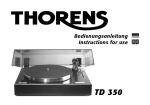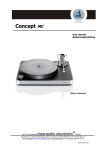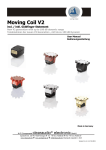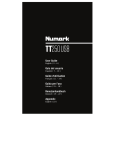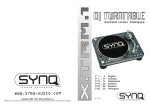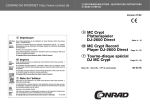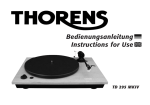Download TD 160 HD
Transcript
TD 160 HD Bedienungsanleitung User Manual Mode d’Emploi www.thorens.com TD 160 HD Bedienungsanleitung User Manual Mode d’Emploi Inhalt EINLEITUNG 6 SICHERHEITSHINWEISE 7 AUSPACKEN UND MONTAGE 8 AUFSTELLUNG UND ANSCHLUSS 11 INSTALLATION DES TONABNEHMERS 13 EINSTELLUNG DER TONARMHÖHE 14 FEINJUSTAGE DES TONABNEHMERS 15 TONARM TP 250 16 TONARM TP 300 17 BETRIEB DES PLATTENSPIELERS 18 WARTUNG UND PFLEGE 19 TECHNISCHE DATEN SERVICEINFORMATIONEN 20 21 Table of Contents INTRODUCTION Table des matiéres 23 INTRODUCTION HINTS FOR SAFETY AND PRECAUTION 24 CONSIGNES DE SECURITE UNPACKING AND ASSEMBLY 25 DEBALLAGE ET MONTAGE 42 SET UP AND CONNECTIONS 28 INSTALLATION ET RACCORDEMENT 45 MOUNTING THE PICKUP CARTRIDGE 30 INSTALLATION DE LA CELLULE DE LECTURE 47 ADJUSTING TONEARM HEIGHT 31 REGLAGE DE LA HAUTEUR DU BRAS 48 ALIGNMENT OF PICKUP CARTRIDGE 32 REGLAGE PRECIS DE LA CELLULE 49 TONEARM TP 250 33 BRAS DE LECTURE TP 250 50 TONEARM TP 300 34 BRAS DE LECTURE TP 300 51 OPERATION 35 UTILISATION DE LA PLATINE 52 36 MAINTENANCE ET ENTRETIEN 53 TECHNICAL SPECIFICATIONS 37 DONNEES TECHNIQUES 54 SERVICE INFORMATION 38 INFORMATIONS SERVICE APRES-VENTE MAINTENANCE AND CARE 40 41 55 Einleitung Herzlichen Glückwunsch zum Kauf Ihres neuen Plattenspielers. Wir hoffen, dass Sie mit Ihrem neuen Plattenspieler viel Freude haben werden. In Verbindung mit einem guten Tonabnehmersystem besitzt dieses Laufwerk herausragende Wiedergabequalitäten. Fertigung und Montage erfolgen komplett in Deutschland, so dass Sie sich auch noch nach Jahren auf das Gerät verlassen können. Bitte denken Sie daran, dass dieser Plattenspieler ein Präzisionsinstrument ist, das stets mit Sorgfalt behandelt werden muss. Wir empfehlen Ihnen daher, diese Bedienungsanleitung vor der ersten Ingebrauchnahme aufmerksam durchzulesen. Sie enthält wichtige Hinweise für Aufstellung, Anschluss und Konfiguration Ihres neuen Laufwerks. Sollten Sie darüber hinaus noch Fragen haben, so können Sie sich jederzeit an Ihren Thorens Fachhändler wenden. 6 Sicherheitshinweise BITTE VOR DER ERSTMALIGEN INBETRIEBNAHME AUFMERKSAM LESEN! Dieses Elektronikprodukt entspricht den gültigen Richtlinien zur Erlangung des CE-Zeichens. Alle notwendigen Prüfungen wurden mit positivem Ergebnis vorgenommen. VORSICHT Um einen elektrischen Schlag zu vermeiden, darf das Gehäuse des Netzteils nicht geöffnet werden. Im Geräteinneren befinden sich keine vom Benutzer zu wartenden Teile. WARNUNG UM DER GEFAHR VON FEUER UND EINES ELEKTRISCHEN SCHLAGES VORZUBEUGEN, DARF DAS GERÄT WEDER REGEN NOCH FEUCHTIGKEIT AUSGESETZT WERDEN. ERLÄUTERUNG DER GRAFISCHEN SYMBOLE Das Blitz-Symbol mit dem nach unten weisenden Pfeil im gleichseitigen Dreieck warnt vor “gefährlicher Spannung” im Gehäuseinneren, deren Höhe für eine Gefährdung von Personen durch einen Stromschlag ausreichend ist. Das Ausrufezeichen innerhalb des gleichseitigen Dreiecks macht auf wichtige Bedienungs- und Wartungshinweise in der beiliegenden Bedienungsanleitung aufmerksam. 2002/95/EC (RoHS) konform. WICHTIG: ENTSORGUNG VON ELEKTROGERÄTEN DURCH VERBRAUCHER IN PRIVATEN HAUSHALTEN INNERHALB DER EU Dieses Symbol auf dem Produkt oder dessen Verpackung gibt an, dass dieses Produkt nicht zusammen mit dem Restmüll entsorgt werden darf. Es obliegt daher Ihrer Verantwortung, das Gerät an einer entsprechenden Stelle für die Entsorgung oder Wiederverwertung von Elektrogeräten aller Art abzugeben (z.B. ein Werkstoffhof). Die separate Sammlung und das Recyceln Ihrer alten Elektrogeräte zum Zeitpunkt ihrer Entsorgung trägt zum Schutz der Umwelt bei und gewährleistet, dass sie auf eine Art und Weise recycelt werden, die keine Gefährdung für die Gesundheit von Mensch und Umwelt darstellt. Weitere Informationen darüber, wo Sie alte Elektrogeräte zum Recyceln abgeben können, erhalten Sie bei den örtlichen Behörden, Werkstoffhöfen oder dort, wo Sie das Gerät erworben haben. 7 Auspacken und Montage Nehmen Sie das Gerät und die mitgelieferten Einzelteile vorsichtig aus der Verpackung. Lieferumfang: 1 x Chassis (mit/ohne Tonarm) 1 x Tonarmgewicht 1 x Thorens Antriebsriemen 1 x Plattenteller 1 x Antistatische Matte (2 Teile) 1 x Spezial Lageröl 1 x Montagehilfe für Antriebsriemen 1 x Steckernetzteil 1 x Cinchkabel 3 x RDC-Gerätefuß 1 x Staubschutzhaube aus Acryl 1 x Wasserwaage (Libelle) 1 x Adapter für 17cm-Schallplatten Bei Beachtung der nachfolgenden Hinweise wird die Montage Ihres neuen Plattenspielers nur wenige Minuten in Anspruch nehmen. 8 Abbildung 1 Schrauben Sie die RDC-Füße an der Unterseite des Chassis an und stellen Sie dieses auf eine ebene Unterlage. Geben Sie nun fünf bis acht Tropfen des mitgelieferten Spezialöls in das Lager und setzen Sie die Achse mit dem dickeren Ende voran in das Lager ein (Abb. 1). Die Montage von Plattenteller und Antriebsriemen erfolgt durch eine spezielle Montagehilfe (Abb. 2.1). Bringen Sie die Metallbügel der Montagehilfe wie in Abb. 2.1 dargestellt in Position. Legen Sie den Plattenteller umgedreht auf eine ebene Unterlage und spannen Sie den Riemen um den integrierten Subteller (Abb. 2.2). Haken Sie nun die Monatgehilfe im Riemen ein und ziehen Sie diesen vorsichtig bis zum Rand des Tellers. Befestigen Sie Riemen und Monagehilfe wie in Abb. 2.3 dargestellt am Tellerrand. Abbildung 2.1 Abbildung 2.2 Abbildung 2.3 Abbildung 2.4 Vermeiden Sie Öl- oder Fettspuren auf Antriebsriemen, Motor-Riemenscheibe und der Lauffläche im Inneren des Plattentellers. Falls notwendig, können Sie diese Teile mit einem in reinem Alkohol getränkten, nicht fasernden Tuch oder Lappen reinigen. Drehen Sie nun den Teller um und setzen Sie ihn vorsichtig auf die Achse. Platzieren Sie ihn dabei so, dass die durch die Montagehilfe gebildete Fläche zwischen Riemen und Subteller genau über der Motor-Riemenscheibe liegt (Abb. 2.4). Der Teller sitzt richtig, wenn er sich nur noch wenige Grad nach links und rechts bewegen lässt. 9 Drehen Sie nun die Drahtbügel der Montagehilfe nacheinander nach innen (Abb. 3.1), hierdurch wird der Riemen freigegeben und legt sich um die Riemenscheibe. Entfernen Sie die Montagehilfe wie in Abb. 3.2 dargestellt. Drehen Sie den Teller anschließend einige Male von Hand um den korrekten Sitz des Riemens zu überprüfen. Legen Sie die spezielle Kautschuk-Polymer-Matte auf den Plattenteller (Abb. 3.3). Die zwei Teile der Matte ermöglichen es, unterschiedlich dicke Schallplatten abzuspielen, ohne die Höhe des Tonarms (VTA, siehe Seite 14) verändern zu müssen. Abbildung 3.1 Wurde Ihr Plattenspieler ohne Tonarm geliefert, so montieren Sie diesen nun bitte nach der Anleitung des Herstellers. Ansonsten ist der Plattenspieler nun vollständig montiert und kann aufgestellt und angeschlossen werden. WICHTIG: Bitte bewahren Sie die Verpackung auf, falls das Gerät einmal zum Transport verpackt werden muss. Für Transportschäden durch unsachgemäße Verpackung wird keine Haftung übernommen! 10 Abbildung 3.3 Abbildung 3.2 Aufstellung und Anschluss Stellen Sie den Plattenspieler auf eine stabile Unterlage und richten Sie ihn so aus, dass er waagrecht steht. Sie können die Höhe der Füße anpassen, indem Sie diese drehen. Kontrollieren Sie die Höheneinstellung danach mithilfe einer Wasserwaage und korrigieren Sie diese gegebenenfalls. Verbinden Sie nun mit Hilfe des Cinchkabels die Ausgangsbuchsen des Plattenspielers mit dem (Phono-) Eingang Ihres Verstärkers. Achten Sie hierbei unbedingt auf eine korrekte Polung (linker-/rechter Kanal!). Hinweis: Für Verstärker ohne Phonoeingang wird zusätzlich ein spezieller Phonovorverstärker benötigt. Für Verstärker mit einer 5-poligen Eingangsbuchse nach DIN wird zusätzlich ein spezielles Adapterkabel benötigt. Bitte wenden Sie sich in diesen Fällen an Ihren Fachhändler. 11 Achten Sie bei der Aufstellung Ihres neuen Plattenspielers darauf, einen Mindestabstand zu anderen elektronischen Geräten (z.B. Verstärker, Receiver oder CD-Spieler) einzuhalten, da es sonst zu magnetischen Einstrahlungen auf das Tonabnehmersystem kommen kann, welche sich durch Brummstörungen in der Wiedergabe äußern. Thorens Plattenspieler sind relativ unempfindlich gegenüber Erschütterungen. Dennoch stellen diese ein generelles Problem bei der Plattenwiedergabe mit hochwertigen Tonabnehmern dar. Wählen Sie deshalb ein möglichst stabiles Möbelstück zur Aufstellung und vermeiden Sie die Nähe zu Lautsprechern. Magnetische Störungen kann man leicht ermitteln und beseitigen, indem man Aufstellung und Position der Geräte zueinander verändert. Leider reicht dies in älteren Häusern mit Holzbalkendecken bisweilen nicht aus. In der Regel hilft hier allerdings die Aufstellung des Plattenspielers auf einer Konsole, die mit geeigneten Konsolenträgern an einer tragenden Zimmerwand befestigt wird. 12 Installation des Tonabnehmers Installieren und konfigurieren Sie Ihr Tonabnehmersystem entsprechend der Montageanleitung des Herstellers und nehmen Sie alle notwendigen Einstellungen vor. An den Thorens Tonarmen können Tonabnehmersysteme mit einem standardisierten Abstand der Befestigungslöcher von 12,5 mm (1/2 ”) montiert werden. Im Folgenden erhalten Sie einige Hinweise zur Installation und Konfiguration von Thorens Tonarmen, die analog auch für andere Fabrikate gelten können. Halten Sie sich jedoch im Zweifel immer an die Anleitung des jeweiligen Herstellers. Spezielle Konfigurationshinweise für den Thorens Tonarm TP 250 / TP 300 finden Sie ab Seite 16. Die vier farblich gekennzeichneten Anschlusslitzen werden auf die entsprechenden Anschluss-Stifte (identische Farbe) des Tonabnehmersystems geschoben. Hinweis: Sollte Ihr Plattenspieler mit montiertem Tonarm und Tonabnehmersystem geliefert worden sein, so sind alle Einstellungen bereits werkseitig vorgenommen. Einzig die Auflagekraft muss noch eingestellt werden, da das Tonarmgewicht für den Transport deinstalliert wurde. Montieren Sie den Tonabnehmer in die dafür vorgesehenen Bohrungen des Tonabnehmerkopfs. Belassen Sie dabei den Nadelschutz – wenn möglich – auf dem Tonabnehmer, um Beschädigungen der Abtastnadel zu vermeiden. R G L G rechter Kanal, rot (Signal) rechter Kanal, grün (Masse) linker Kanal, weiß (Signal) linker Kanal, blau (Masse) Ziehen Sie die Montageschuhe zunächst nur lose ab. Die Feinjustage des Tonabnehmers erfolgt nach dem Einstellen der Tonarmhöhe. Hinweis: Bei Grado Tonabnehmern sollten die mitgelieferten Schrauben von unten durch den Tonabnehmer geführt werden und die Mutter oben auf das Headshell geschraubt werden, da sie am Systemkörper nur schwer zu verwenden sind. 13 Einstellung der Tonarmhöhe Entfernen Sie vorsichtig den Nadelschutz. Legen Sie nun eine Schallplatte auf und senken Sie die Abtastnadel vorsichtig ab. Das Tonarmrohr sollte parallel zur Plattenoberfläche stehen. Ist dies nicht der Fall, so muss die Tonarmhöhe mittels VTA justiert werden. VTA bedeutet Vertical Tracking Adjustment, dieses System ermöglicht es, den Tonarm mithilfe eines Klemmmechanismus (Abb. 4) auf die Höhe des jeweiligen Tonabnehmers einzustellen. Abbildung 4 Drehen Sie das Tonarmgewicht in Richtung der Tonarmbank auf den Tonarm (Abb. 4). ACHTUNG: Gehen Sie im Folgenden extrem vorsichtig vor, da jeder Fehler die Abtastnadel des Tonabnehmers zerstören kann! 14 Um die Einstellung vorzunehmen, müssen Sie zunächst die Klemmschraube öffnen. Anschließend kann der Tonarm in die gewünschte Höhe gebracht werden. Ziehen Sie die Schraube nun vorsichtig wieder an. Einstellung der Auflagekraft: siehe Seite 16/17. Feinjustage des Tonabnehmers Nur bei einer genauen Justage des Tonabnehmersystems kommen die hervorragenden Klangeigenschaften dieses Laufwerks voll zur Geltung. Sollten Sie hierbei Probleme haben, so hilft Ihnen Ihr Fachhändler gerne weiter. ACHTUNG: Bei der Feinjustage des Tonabnehmers ist größte Sorgfalt geboten, damit weder Abtastnadel noch die empfindliche Feinmechanik des Tonarms beschädigt werden. Sollten Sie hierin keinerlei Erfahrung haben, so empfehlen wir Ihnen, dies einem Fachmann zu überlassen. Falsch eingestellte Tonabnehmersysteme können zu starkem Klangverlust bis hin zu Schäden an der Schallplatte führen! Kröpfungswinkel: Der Kröpfungswinkel ist der Winkel zwischen der Längsachse des Tonabnehmers und der Tonarmachse. Bei allen Drehpunktarmen (wie der Tonarm TP 250 / TP 300) liegen die optimalen Werte zwischen 21° und 24°. Zur Einstellung benötigen Sie eine spezielle Schablone, welche im Fachhandel erhältlich ist. Überhang: Der Überhang ist die Strecke, welche die Tonabnehmernadel über die Plattentellermitte hinausragt. Der Überhang sollte beim Tonarm TP 250 / TP 300 ca. 17 mm betragen. Zur Einstellung benötigen Sie eine spezielle Schablone, welche im Fachhandel erhältlich ist. Azimut: Dies ist der Winkel zwischen Nadelträger und Schallplattenrille. Er sollte 90° betragen (hiervon ausgenommen sind Systeme, deren Nadel absichtlich schief eingebaut ist). Der Azimut kann am TP 250 / TP 300 nicht eingestellt werden. Sie sollten mit diesem Tonarm daher nur Tonabnehmer verwenden, die einen korrekten Azimut besitzen. 15 Tonarm TP 250 Einstellung des Tonarmlifts: Die Lifteinstellung dieses Tonarms wird im Werk vorgenommen und passt für nahezu alle Tonabnehmer. Sollte trotzdem eine Nachjustage nötig sein, wenden Sie sich bitte an Ihren Fachhändler. Einstellung der Antiskatingkraft: Die Antiskatingkraft wird durch den auf der Tonarmbank (2) unter dem Tonarm sitzenden Schieberegler eingestellt. Wir empfehlen, die Antiskatingkraft etwas niedriger als die Auflagekraft einzustellen. Einstellung der Auflagekraft: Informieren Sie sich zunächst darüber, welche Auflagekraft für Ihr Tonabnehmersystem empfohlen wird. Im Allgemeinen sind Auflagekräfte zwischen 10 und 25 mN gebräuchlich (1,0 - 2,5 pond). Zunächst muss der Tonarm ausbalanciert werden. Hierzu wird er bei abgesenktem Lift zwischen Tonarmstütze und Tonarm TP 250 16 ➀ ➁ ➂ Plattenteller positioniert und durch Verdrehen des Gegengewichtes in die Waagrechte gebracht. Hinweis: Die Antiskatingkraft sollte hierbei unbedingt auf 0 reduziert werden! Sie können die Auflagekraft nun durch Drehen des Gegengewichts (3) nach folgendem Schema einstellen: Eine halbe Umdrehung des Gewichts entspricht einer Auflagekraft von 10 mN, eine volle entspricht 20 mN. Drehen in Richtung der Tonarmbank erhöht die Auflagekraft, Drehen in entgegengesetzter Richtung verringert sie. Die grünen Punkte am Gewicht dienen zur Orientierung. Arretieren Sie unbedingt den Tonarm, bevor Sie diese Einstellung vornehmen. ➁ Tonarmlift Tonarmbank Gegengewicht ➂ ➀ Tonarm TP 300 Einstellung des Tonarmlifts: Die Lifteinstellung dieses Tonarms wird im Werk vorgenommen und passt für nahezu alle Tonabnehmer. Sollte trotzdem eine Nachjustage nötig sein, wenden Sie sich bitte an Ihren Fachhändler. Einstellung der Antiskatingkraft: Die Antiskatingkraft wird durch den auf der Tonarmbank (2) unter dem Tonarm sitzenden Schieberegler eingestellt. Wir empfehlen, die Antiskatingkraft etwas niedriger als die Auflagekraft einzustellen. Zunächst muss der Tonarm ausbalanciert werden. Hierzu wird er bei abgesenktem Lift zwischen Tonarmstütze und Plattenteller positioniert und durch Verdrehen des Gegengewichtes in die Waagrechte gebracht. Hinweis: Die Antiskatingkraft sollte hierbei unbedingt auf 0 reduziert werden! Die Auflagekraft wird durch eine Feder im Inneren des Tonarms erzeugt. Sie kann mit Hilfe des seitlich am Tonarm sitzenden Drehreglers (4) eingestellt werden. Einstellung der Auflagekraft: Informieren Sie sich zunächst darüber, welche Auflagekraft für Ihr Tonabnehmersystem empfohlen wird. Im Allgemeinen sind Auflagekräfte zwischen 10 und 25 mN gebräuchlich (1,0 - 2,5 pond). Tonarm TP 300 ➀ ➁ ➂ ➃ Arretieren Sie unbedingt den Tonarm, bevor Sie diese Einstellung vornehmen. Tonarmlift Tonarmbank Gegengewicht Drehregler für Auflagekraft ➁ ➀ ➃ ➂ 17 Betrieb des Plattenspielers Der neben dem Plattenteller angeordnete Schalter dient zur Geschwindigkeitsauswahl. Folgende Geschwindigkeiten stehen zur Verfügung: 33 ⅓ U/min für Langspielplatten und 45 U/min für kleine Schallplatten. Befindet sich der Schalter in der Mittelposition (wie in Abb. 6 zu sehen), ist der Plattenspieler ausgeschaltet. Zum Abspielen einer Platte wird der Plattenspieler zunächst mit der entsprechenden Geschwindigkeit gestartet. Dann wird der Tonarmlift angehoben. Hierzu muss der Hebel nach hinten oben bewegt werden. Nun wird der Tonabnehmer über der Einlaufrille oder über dem gewünschten Stück positioniert und anschließend mit Hilfe des Lifts auf die Platte abgesenkt. Bewegen Sie den Lift hierzu leicht nach vorne unten und lassen Sie ihn los. Der Tonarm senkt sich nun langsam von alleine ab. ACHTUNG: Beschleunigen Sie den Absenkvorgang des Tonarmlifts keinesfalls, indem Sie von Hand nachhelfen, da hierdurch Tonabnehmer oder Schallplatte beschädigt werden können. 18 Abbildung 6 Der Plattenspieler besitzt keine automatische Endabschaltung. Sobald die Auslaufrille erreicht ist, muss der Tonarm mittels Handlift von der Platte gehoben und der Plattenspieler abgeschaltet werden. Wartung und Pflege Ihr Plattenspieler benötigt keinerlei ständige Wartung. Von Zeit zu Zeit können Sie fünf bis acht Tropfen des mitgelieferten Spezialöls in das Lager geben, um seine Schmierung zu verbessern (siehe auch Seite 8). Staub, der sich im Laufe der Zeit auf dem Chassis absetzt, kann mit einem weichen und feuchten Tuch entfernt werden. Hinweis: Verwenden Sie zur Reinigung am besten ein feuchtes Brillenputztuch. Ein trockenes Tuch kann unerwünschte elektrostatische Aufladungen verursachen. Den Thorens Präzisionsriemen sollten Sie alle 2 Jahre ersetzen. Sollte das Gerät über längere Zeit nicht in Betrieb sein, so empfiehlt es sich, den Riemen zu demontieren, um einer vorzeitigen Alterung vorzubeugen. 19 Technische Daten Modell TD 160 HD Funktion Antriebssystem Motor Geschwindigkeiten Umschaltung Plattenteller Tonarm Anti-Skating Endabschaltung Kabelkapazität Stromversorgung manuell Riemenantrieb (innenliegend) elektronisch geregelter AC-Synchronmotor 33 ⅓, 45 U/min elektronisch 12” Acrylteller mit 2,0 kg Thorens TP 250 / TP 300 (standard) Magnet (TP 250 / TP 300) – 120 pF externes Steckernetzteil 15 - 18 V AC, min. 300 mA 430 x 175 x 340 mm (B x H x T) 8,0 kg Abmessungen Gewicht Technische Änderungen vorbehalten. Hergestellt in Deutschland. 20 Serviceinformationen Ihr Fachhändler oder Vertrieb sind jederzeit kompetente Ansprechpartner, die Ihnen bei sämtlichen Fragen rund um Ihr Thorens Produkt gerne zur Verfügung stehen. Sie können Thorens auch direkt kontaktieren: Thorens Export Company AG Im Huebel 1, CH-4304 Giebenach, Schweiz www.thorens.com, [email protected] Bitte kontaktieren Sie im Garantiefall immer zuerst Ihren Fachhändler oder Vertrieb! Weitere Informationen unter: www.thorens.com/de 21 Notizen 22 Introduction Congratulations for your purchase of the new TD 160 HD! We hope that your new record player will give you lots of listening pleasure. In combination with a good pickup cartridge this turntable is to yield outstanding sound. Manufacturing and assembly of this record player has been carried out in Germany which will guarantee you its high quality and functionality being maintained for many years to come. Please keep in mind that this device is a precision instrument and therefore requires some attention and care. We strongly advise to read these instructions attentively before proceeding with the set-up as it contains all necessary information and guidance for assembly, placement, set-up and configuration of your new record player. In the event that you have any question this user manual cannot answer please do not hesitate to ask your Thorens dealer for further assistance. 23 Safety instructions PLEASE READ THIS PAGE CAREFULLY BEFORE OPERATING YOUR UNIT! This product was tested and complies with all the requirements for the CE Mark. CAUTION To reduce risk of electric shock, do not remove the cover (or back). No user-serviceable parts inside. WARNING TO PREVENT FIRE OR SHOCK HAZARD, DO NOT EXPOSE THIS APPLIANCE TO RAIN OR MOISTURE. EXPLANATION OF GRAPHICAL SYMBOLS The lightning flash with arrowhead symbol, within an equilateral triangle, is intended to alert you to the presence of uninsulated ‘dangerous voltage’ within the product’s enclosure that may be of sufficient magnitude to constitute an electric shock to persons. The exclamation point within an equilateral triangle is intended to alert you to the presence of important operating and maintenance (servicing) instructions in the literature accompanying the appliance. 24 Compliant to 2002/95/EC (RoHS) IMPORTANT: DISPOSAL OF WASTE EQUIPMENT BY USERS IN PRIVATE HOUSEHOLDS IN THE EUROPEAN UNION This symbol on the product or on its packaging indicates that this product must not be disposed off with your other household waste. Instead, it is your responsibility to dispose of your waste equipment by handing it over to a designated collection point for the recycling of waste electrical and electronic equipment. The separate collection and recycling of your waste equipment at the time of disposal will help to conserve natural resources and ensure that it is recycled in a manner that protects human health and the environment. For more information about where you can drop off your waste equipment for recycling, please contact your local city office, your household waste disposal service or the shop where you purchased the product. Unpacking and Assembly Carefully remove the unit and accessories from the packaging. Supplied items: 1 x plinth (with/without tonearm) 1 x tonearm counterweight 1 x Thorens drive belt 1 x platter 1 x anti-static platter mat (2 parts) 1 x special bearing oil 1 x mounting jig for drive belt 1 x mains power adaptor 1 x set of RCA interconnecting leads 3 x RDC unit feet 1 x acryl dust cover 1 x sprit level (bubble) 1 x adaptor for single records By observing the following hints your record player can be mounted within only a few minutes. Fig. 1 Attach the 3 RDC-feet at the underside of the plinth and put the unit onto a level surface. Now put five to eight drops of the supplied oil into the bearing and then insert the axle with the thicker end first (Fig. 1). 25 Mounting platter and belt is carried out with the dedicated jig supplied (Fig. 2.1). Put the metal stems oft the mounting jig into a position as shown in Fig. 2.1. Put the platter upside down onto a level surface and stretch the rubber belt around the integrated sub-platter (Fig. 2.2). Hook the stems of the mounting jig into belt and carefully pull to the inner rim of the platter. Fix belt and jig at the rim as shown in Fig. 2.3. Fig. 2.1 Fig. 2.2 Fig. 2.3 Fig. 2.4 Avoid any oil or greasy substance to get onto the belt and the transmission area of sub-platter and motor pulley. If necessary you may clean them with a lint-free tissue lightly soaked in an alcoholic dilution (e.g. ethanol). Now turn platter back again and put it carefully onto the bearing axle. Position platter in a way that the area between belt and inner platter rim as formed by the mounting jig is to come exactly over the motor pulley (Fig. 2.4). The platter has been correctly positioned if it can be moved to the left or right by only a few degrees. 26 The stems of the mounting jig are now to be turned inwards, one after the other (Fig. 3.1), whereupon the belt will be freed and loop itself around the motor pulley. Remove the mounting jig as shown in Fig. 3.2. Turn the platter manually clock-wise several times in order to make sure that the belt fits snugly around sub-platter and pulley. Place the dedicated rubber-polymer mat onto platter (Fig. 3.3). The two pieces are to compensate vinyl records of different thickness without having to alter tonearm height (VTA; see page 31). Fig. 3.1 Fig. 3.2 If your TD 160 HD has been delivered without tonearm you may now proceed to mount and align the tonearm of your choice according to the instructions supplied by its manufacturer. Otherwise the mounting of your TD 160 HD is complete and can now be set up and connected. IMPORTANT: it is highly recommended to save the shipping box and all packing material in case your record player needs to be packed again for transportation. Thorens cannot be held responsible for any damage that may occur during transport owing to the record player not been properly packed Fig. 3.3 27 Set up and Connections Place the record player onto a stable foundation and after the final position has been achieved make sure that the plinth is fairly level. For any fine-adjustments turn the tip of each foot up or down until the plinth is in a perfect horizontal position. This procedure is best controlled (and to be corrected if necessary) with the help of the supplied spirit level. Take the RCA interconnect leads and plug them into the designated (phono) input jacks at the rear panel of your amplifier or receiver. Make sure that polarity (left/right channel!) is correct. HINT: if your amplifier lacks an integrated phono stage you need to acquire a special external phono-preamplifier. For amplifiers/receivers featuring a 5-pin DIN-socket at the phono input section you will need a special adaptor (RCA to DIN) which can be requested from your Thorens dealer. 28 While placing the record player onto its final position make sure that it is a fair distance away from other audio devices (such as amplifier, receiver or CD player). This measure is to avoid electro-magnetic interferences which can yield a distorting effect in the sensitive pickup cartridge which may be audible as hum during playback. Electro-magnetic interferences however can be disclosed and eliminated by simply changing the position of the record player with respect to the other audio components. Thorens record players are relatively insensitive when subject to foot-fall shocks or airborne vibrations. Nevertheless, a general problem remains when it comes to playing back vinyl records with a high-quality pickup cartridge. It is therefore highly recommended to choose a sturdy piece of furniture or a rack for placement whereby any close proximity of the record player to the loudspeakers is to be avoided. Under certain circumstances all these precautions may not be good enough in older houses with wooden floor construction. Here, in most cases a solid shelf firmly mounted to a supporting wall can be very beneficial for the sonic properties of the record player if it is placed on such a shelf or console. 29 Mounting the Pickup Cartridge You can now mount and adjust your pickup cartridge according to the instructions provided with the pickup. Proceed with making all necessary alignments. In the following you‘ll find some comprehensive instructions concerning the correct mounting of Thorens tonearms, which may accordingly be used for mounting foreign tonearms as well. However, if in doubt you should in any case resort to the original instructions provided by the manufacturer of the tonearm. Special hints concerning the configuration of the Thorens tonearms TP 250 / TP 300 are to be found on page 33/34 of this manual. Thorens tonearms will accept any pickup cartridge with standard fixing hole distance of 12.5 mm (1/2”). Carefully and with the help of tweezers, the four colourcoded fine litz wires coming from the tonearm‘s headshell are attached to the respective pins with identical colour at the rear side of the cartridge. R G L G right channel, red (signal) right channel, green (ground) left channel, white (signal) left channel, blue (ground) HINT: if you happen to have acquired this record player as a complete system, i.e. with tonearm and pickup, there are no adjustments necessary because everything has already been carried out for you in the Thorens factory. Only tracking force needs to be adjusted. For the time being do not tighten the headshell screws. One should be able to slide the cartridge smoothly back and forth along the headshell slots. Fine-adjusting and fixing the cartridge is done after having determined the final tone arm height. Mount the pickup cartridge to the slots in the tonearm’s headshell. While doing this initial work it is recommended to leave – if possible – the stylus guard attached to the cartridge in order to avoid that the delicate stylus and cantilever are damaged while mounting the cartridge. HINT: if pickups from Grado are going to be employed it is recommended to fix the cartridge with the screws „upside down“. This means that the screws are inserted from underneath through the cartridge holes and the headshell slots. 30 Adjusting Tonearm Height Carefully detach the stylus guard from pickup and put (an old) record onto the platter. After that lower the tonearm by the lift lever. The tonearm tube should then be parallel to the record (to be viewed from the side). If this is not the case the so-called Vertical Tracking Angle (VTA) needs to be adjusted by the tonearm height. However the special clamp mechanism (Fig. 4) provided allows to individually adjust VTA according to the size of the mounted pickup. Fig. 4 The counterweight is attached to the rear end of the tonearm by some slight pressure and a clockwise rotation towards the tonearm’s bearings (Fig. 4). This adjustment is made by loosening the screw of the clamp mechanism and carefully sliding the tonearm slightly up or down. If necessary repeat this procedure until the tonearm tube is fully parallel to the record. After the position for a correct VTA has been found, do not forget to tighten the clamp screw again. Adjustment of tracking force: see page 33/34. ATTENTION: great care is necessary for the following mounting and adjustment procedures, because the slightest mistake may damage stylus and cantilever. 31 Alignment of Pickup Cartridge Only a painstakingly aligned pickup is able to compliment the outstanding sonic capabilities and potential of this record player. If you consider the alignment too difficult to be carried out by yourself, do not hesitate to ask your Thorens dealer for a helping hand. ATTENTION: when aligning the cartridge great care is once again obligatory in order to avoid that the delicate stylus or sensitive parts of the tonearm are being damaged. If you are a newcomer without any experience it is better to leave this work to an expert who knows the specific characteristics of most pickups and tonearms. A badly aligned pickup will be well on the way to yield bad sound and to damage your precious records! Azimut: is the angle between cantilever/stylus interface and record groove. It should be exactly 90° (excluding those cartridges in which the cantilever has purposely been installed with a slight offset). Azimuth cannot be adjusted on the TP 250 / TP 300. It is therefore most important that a pickup with precise azimuth is going to be 32 Offset: is the angle between the longitudinal axis of the pickup and the tonearm‘s longitudinal axis. In all pivoted tonearms (like the TP 250 / TP 300) the optimum value is to be found between 21° and 24°. Dedicated pickup alignment gauges required for this adjustment work are available from your Thorens dealer. Overhang: is the distance between the stylus tip and the centre of the platter spindle. For the TP 250 / TP 300 overhang should be 17 mm. Special pickup alignment gauges required for this adjustment are available from your Thorens dealer. Tonearm TP 250 Adjusting the tonearm lift: this has already been adjusted in the factory and can be considered suitable for nearly all pickups in the market. However if the lift needs to be re-adjusted to fit a very special cartridge, please do not hesitate to ask your Thorens dealer for help. Anti-skating force (bias): this is adjusted by shifting the button on the tonearm‘s lift bench (2). It is recommended to set the anti-skating force slight below the value of the tracking force. Adjustment of tracking force: make sure to inquire the recommended tracking force for your pickup from either the cartridge manufacturer or by consulting the mounting instructions supplied with the pickup. Tracking force is usually adjusted between 10 and 25 mN (corresponding to 1.0 and 2.5 grams). First lower the lift lever and move the tonearm to a position in between its rest and the outer rim of the platter. Tonearm TP 250 ➀ ➁ ➂ Then balance the tonearm by rotating the counterweight (clockwise or counter-clockwise) until equilibrium has been achieved. HINT: anti-skating force (bias) must in any case be set to “0”. Now you can apply tracking force by rotating the counterweight (3) according to the following scheme: a half turn of the counterweight corresponds to a tracking force of 10 mN (1.0 g) whereas a full turn corresponds to a force of 20 mN (2.0 g). Turning the counter-weight towards the bearings will increase tracking force, whilst turning it into the opposite direction will decrease tracking force. The green dot on the counter-weight is to measure the turns. Make sure the tonearm is kept in its armrest before making these adjustments. ➁ tonearm lift lever tonearm bench counterweight ➂ ➀ 33 Tonearm TP 300 Adjusting the tonearm lift: this has already been adjusted in the factory and can be considered suitable for nearly all pickups in the market. However if the lift needs to be re-adjusted to fit a very special cartridge, please do not hesitate to ask your Thorens dealer for help. Anti-skating force (bias): this is adjusted by shifting the button on the tonearm‘s lift bench (2). It is recommended to set the anti-skating force slight below the value of the tracking force. Adjustment of tracking force: make sure to inquire the recommended tracking force for your pickup from either the cartridge manufacturer or by consulting the mounting instructions supplied with the pickup. Tracking force is usually adjusted between 10 and 25 mN (corresponding to 1.0 and 2.5 grams). Tonearm TP 300 34 ➀ ➁ ➂ ➃ tonearm lift lever tonearm bench counterweight anti-skating dial knob First lower the lift lever and move the tonearm to a position in between its rest and the outer rim of the platter. Then balance the tonearm by rotating the counterweight (clockwise or counter-clockwise) until equilibrium has been achieved. HINT: anti-skating force (bias) must in any case be set to “0”. Tracking force is applied by a spring inside the bearing assembly. You can adjust the tracking force by turning the dial knob (4) at the bearing assembly. Make sure the tonearm is kept in its armrest before making these adjustments. ➁ ➃ ➀ ➂ Operation The lever switch on the left next to the platter is the speed selector. There are two speeds available: 33 rpm for longplaying records and 45 rpm for singles. If the lever is in middle position (as shown in Fig. 6), the record player is switched off. For playing a record the turntable is first started with the desired speed. Then lift the tonearm by slowly pushing the lift lever up. Release the tonearm from its rest and position it above the lead-in groove or above the desired piece/ track to be played. Slowly bring the lift lever into the downposition whereupon the tonearm is smoothly descending onto the record. ATTENTION: please do not attempt to accelerate the descending movement of the tonearm by applying force with your finger tip, because this will inevitably damage both stylus and record. Fig. 6 This record player does not feature an automatic end-ofrecord shut-off facility. Therefore, as soon as the stylus has reached the lead-out groove, the tonearm is to be lifted up manually by the lever and the motor switched off. 35 Maintenance and Care Your record player needs no particular maintenance. From time to time however you may add five to eight drops of the bearing oil in order to enhance lubrication (see also page 25). If over the time dust has collected on the plinth or dust cover you can wipe it off with a soft, moistened cloth. HINT: a moistened cleaning tissue for glasses will do a good job here. Refrain from using a dry cloth for cleaning because this will in any case generate undesired electrostatic charges. The Thorens precision belt should be exchanged at least every other year. If the record player is not in use for a longer time, it is advisable to remove the belt in order to prevent a premature ageing under tension. 36 Technical Specifications Model TD 160 HD Function Drive system Motor Speed Speed change Platter Tonearm Anti-skating (bias) Automatic shut-off Capacity of RCA leads Voltage/Power supply manual operation belt drive (internally via integrated sub-platter) electronically controlled AC synchronous motor 33 and 45 rpm electronically Acryl platter 300 mm (12“), 2.0 kg Thorens TP 250 / TP 300 (standard) by magnet (in TP 250 / TP 300) n/a 120 pF external mains adaptor 15 - 18 V AC, min. 300 mA 430 x 175 x 340 mm (W x H x D) 8.0 kg Dimensions (WxHxD) Weight Technical specifications subject to change. Handmade in Germany. 37 Service Information Your Thorens dealer or distribution partner shall be pleased to assist you in the event that you have any further queries or need additional information concerning Thorens products. You may contact Thorens also directly: Thorens Export Company Ltd. Im Huebel 1, CH-4304 Giebenbach, Switzerland www.thorens.com / [email protected] In case of warranty claims you are kindly requested to first contact your Thorens dealer or distribution partner! Further information may be obtained from: www.thorens.com 38 Notes 39 Introduction Félicitations pour l’achat de votre nouvelle platine. Nous espérons que vous aurez beaucoup de plaisir avec l’utilisation de votre nouvelle platine. Equipée d’une cellule de lecture de bonne qualité, cette platine vous offrira une excellente qualité de reproduction. La fabrication et le montage sont entièrement effectués en Allemagne, ce qui vous garantit un usage satisfaisant pour de longues années. Veuillez lire avec attention la totalité de ce mode d’emploi avant la première mise en service. Il contient d’importants conseils pour l’installation, le raccordement et la configuration de votre nouvelle platine. N’oubliez jamais que cette platine est un instrument de précision, qui doit toujours être manipulé avec précaution. Si vous aviez des questions dont les réponses ne se trouveraient pas dans ce mode d’emploi, veuillez vous adresser à votre revendeur. 40 Consignes de sécurité A LIRE ATTENTIVEMENT AVANT LA PREMIERE MISE EN SERVICE! Ce produit électronique est conforme aux directives européennes pour l‘obtention de la marque CE. Tous les essais nécessaires ont été effectués avec un résultat positif. ATTENTION Pour éviter tout choc électrique, le boîtier de l’alimentation ne doit pas être ouvert. A l’intérieur de l’appareil ne se trouve aucune pièce nécessitant un entretien de la part de l’utilisateur. AVERTISSEMENT POUR EVITER TOUT DANGER D‘INCENDIE ET DE CHOC ELECTRIQUE, L‘APPAREIL NE DOIT PAS ETRE EXPOSE A LA PLUIE ET A L‘HUMIDITE. EXPLICATION DES SYMBOLES GRAPHIQUE Le symbole éclair avec flèche vers le bas dans le triangle avertit d‘une „tension dangereuse“ à l‘intérieur de l‘appareil, dont le niveau est suffisant pour présenter un danger de choc électrique aux personnes. Le point d‘exclamation à l‘intérieur du triangle indique des instructions de commande et d‘entretien figurant dans le présent mode d‘emploi. Conforme à la directive 2002/95/EC (RoHS) IMPORTANT: ELIMINATION D‘APPAREILS ELECTRIQUES PAR LES UTILISATEURS PARTICULIERS RESIDANT DANS LA CE Ce symbole, figurant sur le produit ou sur son emballage, indique que ce produit ne doit pas être éliminé avec les ordures ménagères. Il est de votre responsabilité de remettre ce produit à une entreprise d‘élimination ou de recyclage d‘appareils électriques de tous types (par ex. une décharge spécialisée) La collecte sélective et la réutilisation de tous vos anciens appareils électroniques à l‘occasion de leur élimination, contribuent à la protection de l‘environnement et assure qu‘il soient recyclés de manière à éviter de porter atteinte à la santé humaine et à la protection de la nature. Pour obtenir de plus amples informations sur les dépôts et le recyclage des appareils électroniques usagés, adressez-vous aux autorités locales, aux déchèteries ou au distributeur qui vous a vendu l‘appareil. 41 Déballage et montage Sortez avec précaution de l’emballage, l’appareil et les pièces détachées livrées. Contenu de la livraison: 1 x Châssis (avec/sans bras) 1 x Contre-poids de bras 1 x Courroie Thorens 1 x Plateau 1 x Tapis antistatique (2 parties) 1 x Huile spéciale pour palier 1 x Outil de montage de courroie 1 x Bloc secteur 1 x Câble Cinch 3 x Pied RDC 1 x Capot antipoussière acrylique 1 x Niveau à bulle (Libelle) 1 x Adaptateur pour disque 17 cm En respectant les instructions suivantes, le montage de votre nouvelle platine ne prendra que quelques minutes. 42 Fig. 1 Vissez les pieds RDC sous le châssis et posez celui-ci sur un support plan. Versez maintenant cinq à huit gouttes de l’huile spéciale fournie dans le palier et insérez l’axe avec la grande extrémité dans le palier (Fig. 1). Le montage du plateau et de la courroie s’effectue avec un outil de montage spécial (Fig.2.1). Positionnez les étriers de montage comme indiqué sur la Fig. 2.1. Posez le plateau à l’envers sur un support plan et tendez la courroie sur le plateau inférieur intégré (Fig. 2.2). Accrochez maintenant l’outil de montage à la courroie et tirez-le prudemment jusqu’au bord du plateau. Fixez la courroie et l’outil de montage au bord du plateau comme représenté sur la Fig.2.3. Fig. 2.1 Fig. 2.2 Fig. 2.3 Fig. 2.4 Evitez des traces d’huile ou de graisse sur la courroie d’entraînement, la poulie du moteur et la surface d’entraînement à l’intérieur du plateau. Si nécessaire, vous pouvez nettoyer ces pièces avec un chiffon non pelucheux imprégné d’alcool pur. Retournez maintenant le plateau et placez-le prudemment sur son axe. Placez-le de telle façon que la surface formée par l’outil de montage entre courroie et plateau inférieur soit exactement située au–dessus de la poulie du moteur (Fig. 2.4). Le plateau est en bonne position, s’il ne peut être déplacé que de quelques degrés vers la gauche ou la droite. 43 Tournez maintenant les étriers de l’outil de montage l’un après l’autre vers l’intérieur (Fig. 3.1), ceci libère la courroie et elle se place autour de la poulie. Enlevez l’outil de montage comme représenté sur la Fig. 3.2. Faites ensuite tourner le plateau à la main plusieurs fois pour vérifier la bonne position de la courroie. Posez le tapis spécial en caoutchouc polymère sur le plateau (Fig. 3.3). Les deux parties du tapis permettent d’écouter des disques de différentes épaisseurs sans modifier la hauteur du bras de lecture (VTA, voir page 48). Fig. 3.1 Si votra platine a été livrée sans bras de lecture, montez celui-ci selon les instructions du fabricant. Dans le cas contraire, la platine est maintenant entièrement montée et peut être installée et raccordée. IMPORTANT : prière de conserver l’emballage, au cas où l’appareil devrait être emballé pour le transport. Nous déclinons toute garantie pour dommages dus à un emballage non-conforme. 44 Fig. 3.3 Fig. 3.2 Installation et raccordement Installez la platine sur un support stable et réglez son horizontalité. Vous pouvez adapter la hauteur des pieds, en les tournant. Contrôlez le réglage à l’aide d’un niveau à bulle et corrigez-le si nécessaire. Raccordez maintenant les douilles de sortie de la platine avec l’entrée (phono) de votre amplificateur à l’aide du câble Cinch. Veillez absolument à la bonne polarité (canal gauche/droit !). Remarque : pour un amplificateur sans entrée phono, il faut utiliser en plus un préamplificateur phono spécial. Pour un amplificateur avec une douille d’entrée 5 pôles selon DIN, il faut utiliser en plus un câble adaptateur spécial. Dans ces cas là adressez-vous à votre revendeur. 45 Lors de l’installation de votre nouvelle platine, veillez à respecter une distance minimale par rapport à d’autres appareils électroniques (par exemple amplificateurs, récepteurs ou lecteurs de CD), car il pourrait en résulter des rayonnements magnétiques sur le système de lecture, qui pourraient engendrer des ronflements lors de la reproduction. Les platines Thorens sont relativement insensibles aux secousses. Cependant, ces dernières représentent en général un problème pour les cellules de lecture de qualité supérieure lors de la reproduction du son. C’est pourquoi, nous vous conseillons de choisir un meuble aussi stable que possible pour l’installation et d’éviter la proximité de haut-parleurs. On peut facilement détecter et éliminer des perturbations magnétiques, en modifiant l’installation et la position respectives des appareils. Malheureusement, cela peut être insuffisant dans des maisons avec poutraison de plancher en bois. En général, il suffira de placer la platine sur une console, qui sera ellemême fixée à la paroi porteuse de la pièce, à l’aide des supports de console appropriés. 46 Installation de la cellule de lecture Installez et configurez votre cellule de lecture conformément aux instructions de montage du fabricant et procédez à tous les réglages nécessaires. On peut monter sur les bras de lecture Thorens des cellules de lecture avec un écart standard des trous de fixation de 12,5 mm (1/2 pouce). Ci-après, vous trouverez quelques instructions pour l’installation et la configuration du bras de lecture Thorens, qui peuvent être valables pour des fabrications similaires. En cas de doute, suivez toujours les instructions de chacun des fabricants. Vous trouverez des instructions spéciales de configuration pour le bras de lecture Thorens TP 250 / TP 300 à partir de la page 50. Les quatre cosses de raccordement identifiées par des couleurs doivent être reliées aux broches correspondantes (couleur identique) de la cellule de lecture. Remarque : si votre platine a été livrée avec le bras et la cellule de lecture montés, tous les réglages ont déjà été effectués en usine. Seule la force d’appui doit encore être réglée, car le contre-poids du bras de lecture a été démonté pour le transport. Montez la cellule de lecture dans les trous de la tête de lecture, prévus à cet effet. Pour cela, ne retirez pas – si possible -la protection de l’aiguille de la cellule, pour éviter de l’endommager. R G L G Canal droit, rouge (signal) Canal droit, vert (masse) Canal gauche, blanc (signal) Canal gauche, bleu (masse) Ne serrez pas complètement les pattes de montage. Le réglage final de la cellule de lecture se fera après le réglage de la hauteur du bras. Remarque : pour les cellules de lecture Grado insérez les vis fournies par le dessous de la cellule et vissez les écrous par le dessus de la coque de tête, car elles sont trop difficilement utilisables sur le corps de cellule. 47 Réglage de la hauteur du bras de lecture Retirez prudemment la protection de l’aiguille. Posez maintenant un disque sur le plateau et baissez prudemment l’aiguille de lecture. Le tube du bras de lecture doit être parallèle à la surface du disque. Si cela n’était pas le cas, la hauteur du bras doit être ajustée avec le VTA. VTA signifie Vertical Tracking Adjustment, ce système permet de régler le bras à l’aide d’un mécanisme de serrage (Fig. 4) à la hauteur de chaque cellule de lecture. Fig. 4 Tournez maintenant le contre-poids du bras sur le bras dans la direction de son support (Fig. 4). ATTENTION : procédez ensuite avec une extrème précaution, car chaque erreur risque de détruire l’aiguille de lecture de la cellule ! 48 Pour procéder à ce réglage, vous devez d’abord desserrer les vis de serrage. Le bras de lecture peut alors être amené à la hauteur souhaitée. Resserrez ensuite prudemment les vis. Réglage de la force d’appui : voir page 50/51. Réglage précis de la cellule de lecture Seul un réglage précis de la cellule de lecture permet de mettre en valeur les excellentes caractéristiques sonores de cette platine. Si vous rencontrez des difficultés à ce sujet, faites appel à votre revendeur qui vous aidera volontiers. ATTENTION : le réglage précis de la cellule de lecture exige le plus grand soin, afin d’éviter tout dommage de l’aiguille de lecture et de la mécanique de précision du bras de lecture. Si vous n’avez aucune expérience dans ce domaine, nous vous recommandons de faire appel à un spécialiste. Des cellules de lecture mal réglées peuvent occasionner des pertes importantes de son et même endommager les disques ! Angle de coude : l’angle de coude est l’angle entre l’axe longitudinal de la cellule de lecture et l’axe du bras de lecture. Pour tous les bras rotatifs (comme le bras de lecture TP 250 / TP 300) les valeurs optimales se situent entre 21° et 24°. Il faut un gabarit spécial, disponible chez les revendeurs spécialisés, pour effectuer ce réglage. Longueur de porte-à-faux : le porte-à-faux est la longueur de déplacement de l’aiguille au-delà du centre du disque. Le porte-à-faux du bras de lecture TP 250 / TP 300 doit être d’environ 17 mm. Il faut un gabarit spécial, disponible chez les revendeurs spécialisés, pour effectuer ce réglage. Azimut: il s’agit de l’angle entre le porte-aiguille et le sillon du disque. Il doit être de 90° (à l’exception des systèmes dont les aiguilles sont volontairement montées en biais). L’azimut ne peut pas être réglé sur le TP 250 / TP 300. N’utilisez avec ces bras de lecture que des cellules qui ont un azimut correct. 49 Bras de lecture TP 250 Réglage du lève-bras : le réglage du lève-bras de ce bras de lecture est réalisé en usine et convient à presque tous les types de cellule. Si une correction de réglage s’avérait malgré tout nécessaire, veuillez vous adresser à votre revendeur. Réglage de la force antiskating : la force antiskating se règle à l’aide du réglage coulissant situé sur le support du bras (2) sous le bras de lecture. Nous recommandons de régler la force antiskating à une valeur légèrement inférieure à celle de la force d’appui. Pour ce faire, il doit être placé entre le plateau et le support de bras lorsque le lève-bras est en position basse et ensuite amené en position horizontale par rotation du contre-poids. Remarque : pour effectuer ce réglage, il faut absolument que la force antiskating soit réduite à zéro ! Vous pouvez maintenant régler la force d’appui par rotation du contre-poids (3) selon le schéma suivant : Une demi-rotation du contre-poids correspond à une force d’appui de 10 mN, une rotation complète correspond à 20 mN. Par rotation dans le sens horaire, la force d’appui augmente, dans l’autre sens elle diminue. Les points verts sur le contre-poids servent de repères. Réglage de la force d’appui : renseignez-vous d’abord sur la force d’appui recommandée pour votre cellule de lecture. En général les forces d’appui courantes se situent entre 10 et 25 mN (1,0 – 2,5 pond). Le bras de lecture doit d’abord être équilibré. Bras de lecture TP 250 50 ➀ ➁ ➂ Bloquez absolument le bras de lecture avant d’effectuer ce réglage. ➁ Lève-bras Palier du bras de lecture Contrepoids ➂ ➀ Bras de lecture TP 300 Réglage du lève-bras : le réglage du lève-bras de ce bras de lecture est réalisé en usine et convient à presque tous les types de cellule. Si une correction de réglage s’avérait malgré tout nécessaire, veuillez vous adresser à votre revendeur. Réglage de la force antiskating : la force antiskating se règle à l’aide du réglage coulissant situé sur le support du bras (2) sous le bras de lecture. Nous recommandons de régler la force antiskating à une valeur légèrement inférieure à celle de la force d’appui. Réglage de la force d’appui : renseignez-vous d’abord sur la force d’appui recommandée pour votre cellule de lecture. En général les forces d’appui courantes se situent entre 10 et 25 mN (1,0 – 2,5 pond). Bras de lecture TP 300 ➀ ➁ ➂ ➃ Le bras de lecture doit d’abord être équilibré. Pour ce faire, il doit être placé entre le plateau et le support de bras lorsque le lève-bras est en position basse et ensuite amené en position horizontale par rotation du contre-poids. Remarque : pour effectuer ce réglage, il faut absolument que la force antiskating soit réduite à zéro ! La force d’appui est produite par un ressort situé à l’intérieur du bras. La force d’appui peut être réglée à l’aide de la molette tournante (4) située sur le côté du bras. Bloquez absolument le bras de lecture avant d’effectuer ce réglage. Lève-bras Palier du bras de lecture Contrepoids Molette de réglage de la force d’appui ➁ ➃ ➀ ➂ 51 Utilisation de la platine Le commutateur situé à côté du plateau sert à la sélection de la vitesse de rotation. Les vitesses suivantes sont disponibles : 33 t/mn pour les disques longue durée et 45 t/mn pour les petits disques. Lorsque le commutateur est en position centrale (comme sur la Fig. 6 ), la platine est à l’arrêt. Pour écouter un disque, lancez d’abord la platine avec la vitesse correspondante. Soulevez ensuite le bras de lecture. Soulevez pour cela le levier vers l’arrière. Positionnez maintenant la cellule au dessus du sillon d’entrée du disque ou celui du morceau choisi et abaissez-la sur le disque à l’aide du levier. Tirez le levier en avant vers le bas et lâchez-le. Le bras de lecture descend lentement de lui-même. ATTENTION : ne forcez pas la descente du bras manuellement, vous risqueriez d’endommager la cellule de lecture ou le disque. 52 Fig. 6 La platine n’est pas équipée d’un arrêt automatique de fin de disque. Dès que le sillon de fin de disque est atteint, le bras de lecture doit être soulevé manuellement par le lèvebras et la platine doit être arrêtée. Maintenance et entretien Votre platine ne nécessite pas d’entretien permanent. De temps en temps, vous pouvez déposer cinq à huit gouttes de l’huile spéciale fournie, dans le palier, pour améliorer sa lubrification (voir aussi page 42). La poussière qui se dépose avec le temps sur le châssis, peut être éliminée avec un chiffon doux humide. Remarque : utilisez de préférence un petit chiffon humide pour nettoyage de lunettes. Un chiffon sec peut provoquer des charges électrostatiques indérisables. Vous devriez remplacer tous les deux ans la courroie de précision Thorens. Si l’appareil n’est pas utilisé pendant une période assez longue, il est recommandé de démonter la courroie, pour éviter son vieillissement prématuré. 53 Données techniques Modèle TD 160 HD Fonctionnement Système d’entraînement du moteur manuel Entraînement par courroie (interne) moteur avec régulation électronique Moteur synchrone AC 33 1/3, 45 t/mn électronique Plateau acrylique 12 pouces / 2,0 kg Thorens TP 250 / TP 300 (standard) Aimant (TP 250 / TP 300) 120 pF Bloc secteur externe 15 - 18 V AC, min. 300 mA 430 x 175 x 340 mm (L x H x P) 8,0 kg Vitesses Commutation Plateau Bras de lecture Antiskating Arrêt automatique Capacité du câble Alimentation electrique Dimensions Poids Sous réserve de modification technique. Fabriqué en Allemagne. 54 Information service après-vente Votre revendeur ou votre distributeur sont à tout instant vos partenaires compétents, qui sont volontiers à votre disposition pour répondre à toutes questions concernant votre produit Thorens. Vous pouvez aussi contacter directement Thorens : Thorens Export Company S.A. Im Huebel 1, CH-4304 Giebenach, Suisse www.thorens.com, [email protected] Pour des questions de garantie, prière de contacter toujours d’abord votre revendeur ou distributeur ! Pour de plus amples informations voir : www.thorens.com 55 Notes 56 57 58 © 2007 Thorens Export Company AG Im Huebel 1, CH-4304 Giebenach E-Mail: [email protected] Internet: www.thorens.com analog high fidelity Printed in Germany · UM160HD-0707-A
This document in other languages
- français: Thorens TD 160 HD
- Deutsch: Thorens TD 160 HD




































































